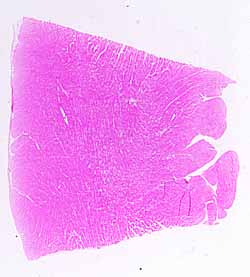
This specimen may be difficult or easy, depending on how quickly you recognize the key features.Hopefully, you recognized that the uncut surfaces of this specimen are not mucosal, and hence probably belong to the various internal surfaces of the body.
The principal clue in this specimen is provided by the rather uniform tissue which comprises the bulk of the sample. If you haven't yet looked closely at this tissue, do so now.
Notice that this tissue is organized into fibers, some cut longitudinally, some in cross-section.
Hopefully, you have recognized that the bulk of this specimen consists of muscle tissue rather than some other fibrous tissue. The critical question then is, What kind of muscle?
- How many different kinds of muscle are found in the human body?
- How do these three kinds of muscle differ from one another?
- Examine the tissue in the specimen for:
- Fiber size and shape.
- Location of nuclei in individual fibers (don't be misled by stromal nuclei -- fibroblasts and capillary endothelium).
- Presence or absence of distinct striations (this latter feature of course requiring longitudinally-sectioned fibers for evaluation).
- Any other details that might offer helpful confirmation.
No more hints.
